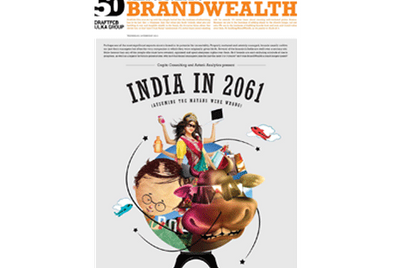
Prof. Kevin Lane Keller, E.B. Osborn Professor of Marketing at the Tuck School of Business at Dartmouth College, conducted a day-long seminar on ‘Building Powerful & Profitable Brands - In Good and Bad Times’ on 10 March 2014, in Mumbai. The seminar was organized by FCBUlka’s Cogito Consulting in association with Somaiya Institute of Management Studies and Research.
Among other things, his talk covered aspects such as the importance of brands, positioning of a brand and brand hierarchy. The workshop was attended by members from the marketing and advertising fraternity.
PODs, POPs and the brand mantra
The author of ‘Strategic Brand Management’ and ‘Marketing Management’ (with Philip Kotler) listed ‘points of difference’ (POD’s), ‘points of parity’ (POP’s) and brand mantra as the standard essentials for brand positioning.
Keller explained that PODs, the set of traits that set a brand apart from competitors, cannot help to figure the best positioning strategy unless coupled with POP and a brand mantra. POP, he added, should help a brand in establishing or cultivating a sense of trust and confidence between the brand and the consumer. He defined brand 'mantra' as a group of four to five words that capture what the brand stands for. In terms of brand positioning, the mantra should be treated as a common thread which runs through every marketing strategy undertaken by the brand and tie it up with the goal set up by the brand or company, he added.
“Mantras provide focus in that they help to communicate what the brand is about, simplify its image or perception and generate interest about the brand. Subway, the American fast food outlet, married its POD, POP and mantra to combine things that generally don’t go together i.e. taste and health - this case remains an example of best positioning strategies,” explained Keller.
Citing another example, he pointed to Nike's 'two very clear and definitive' mantras. The internal mantra for Nike has remained ‘Authentic. Athletic. Performance.’ The external mantra, meanwhile, is the famous ‘Just Do It’ slogan, he explained.
Asked about where a brand should draw the line between a mantra and boxing the product in, Keller said, “Mantra isn’t a static entity. It encourages progress. But one should only change the mantra when there is a fundamental change in the product or brand.”
Highlighting the role of influencers, he said, "Great brands are born out of opportunity. If you create a product that satisfies the needs of a consumer base, the product will be talked about, learned about, written about. This is especially true for a new brand or product. It's when your friends, family recommend it to you - that's when you say 'Ok, that's great'."
The speaker urged brands to avoid ‘Death by 1000 cuts’, adding how small strategy top-ups can be harmful in the long run. He cautioned marketers to avoid making multiple decisions which may seem like strategies at the time but essentially lead to loss of focus on brand goals.
"As a brand, I want to be really careful not to be changing my positions too often. You want to satisfy the consumer, not confuse him. This comes back to the point of having very clear PODs and POPs," he elaborated.
Reiterating the need to have a clearly defined positioning strategy, Keller said, “It comes back to PODs. You can have performance-driven PODs or image-driven PODs. The moment you find a fair mix of both of these two, the better off the brand will be.”
And strategy, Keller said, does not end at the drawing table but only after successful execution.
Turning the spotlight on the consumer, Prof Keller said marketers must understand how a consumer perceives their brand. “Although, this shouldn’t be to the extent that brands start spending undue energies trying to position themselves for the lowest common denominator,” he cautioned.
Keller added, "Brands need to overcome their perceived vulnerability because the more you talk about the advantages of your product, the more will you lose sight of your brand's vulnerabilities. People need to buy as well as use your product. Consumers think in terms of need. Marketers need to make the consumer think of their brand easily, often, at the right time and at the right place.”
The brand substitution test
On the subject of brand architecture and developing strategies for the same, Keller advocated the ‘brand substitution test’.
“Apply your strategy to that of your competitor brands to check if it is unique enough for your product/s. Substitute your competitor into your strategy plan - if it works, then it isn’t good for you. Take a category benefit and make it unique to your product/s,” he said.
Broad access points
“Nike has a very broad access point. Broad access point means that a brand is relevant to a very large consumer base,” explained Keller. Referencing Nike, Keller said the brand marketed not just to athletes, but treated every individual as one. “It did this while still adhering to the marketing rules of the product being desirable, differentiable and deliverable,” he said.
Summarising what brands need to do to position themselves better, Keller outlined:
- Define the needs a brand or product satisfies
- Lock down what ‘branding’ means for a particular company
- Avoid constant repositioning
- Have broad access points
Campbell Soup’s Prego
Keller substantiated his points with some examples. The first was on Campbell Soup Company.
“Campbell Soup Company, an American company that produces canned soups and related products, wanted to break out of the ‘save-for-emergencies’ food category. After much deliberation, they came up with a tomato paste (much thicker than soup) and subjected the product to market testing. The market testing showed disastrous results with outright rejection of the product as the consumers couldn’t disassociate themselves from the runny tomato soup that they had been acclimatised to for so many years,” he explained.
Campbell then decided not to tinker with the product itself. Instead, they opted to change the name of the product to ‘Prego Pasta Sauce’, thus creating a sub-brand. The same tomato sauce which was earlier rejected was now looked up to as an Italian sauce, said the speaker.
View one of the ads for Prego here:
He cited Nivea as a brand that best understands itself. Keller said, “Nivea exhibits focused and controlled positioning and never wavers from its key message regarding its products which are centered on qualities of being ‘gentle’, ‘mild’ and providing ‘protection’.”
Coca Cola Real
Referring to a Coca-Cola campaign that did not connect, he reasoned, “The campaign failed as nobody involved in the planning process of it had a clear idea of what message Coca Cola wanted to send across. The main problem with this campaign was that any cola brand could have done this and hence it failed the brand substitution test. This was before the much successful ‘Open Happiness’ and ‘Share a Coke’ campaigns.”



.jpg&h=334&w=500&q=100&v=20250320&c=1)



.jpg&h=334&w=500&q=100&v=20250320&c=1)
.jpg&h=334&w=500&q=100&v=20250320&c=1)


.jpg&h=334&w=500&q=100&v=20250320&c=1)








